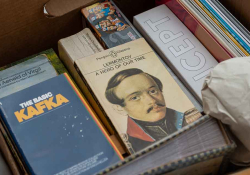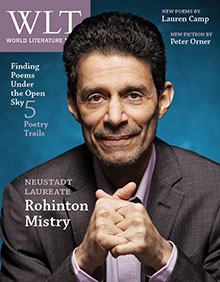Rohinton Mistry’s Omniscient Gaze
It’s not only individual lives that Mistry paints with such meticulousness; it’s how he stretches his canvas to embrace the wider world that makes his work comparable to the contemporary giants of literature.

I was in graduate school at Ohio University in the late 1980s, an aspiring writer from Nepal, when I read Rohinton Mistry’s Swimming Lessons and Other Stories from Firozsha Baag. Those years I didn’t have authors in English from my own country I could turn to, so it was mostly Indian writers whose work I was devouring. I’d already felt the heady jolt of Salman Rushdie’s Midnight’s Children, as many writers of my generation had. There were also others I was reading: Anita Desai, Bharati Mukherjee, Amitav Ghosh. And now here was Rohinton Mistry, and I knew that I had encountered someone who could teach me a thing or two about, as Raja Rao (the 1988 Neustadt winner) put it decades ago, “how to convey in a language that is not one’s own the spirit that is one’s own.”
In a story called “Squatter” in Swimming Lessons, a young Indian who has immigrated to Canada finds that he is able to adapt to the Western way of life in everything, except one: in the bathroom he finds himself unable to sit on the commode and has to squat, desi-style. Even after living in Toronto for ten years, this character is “depressed and miserable, perched on top of the toilet, crouching on his haunches, feet planted firmly for balance upon the white plastic oval of the toilet seat.” But our hero doesn’t give up trying. “Each morning he seated himself to push and grunt,” Mistry writes, “grunt and push, squirming and writhing unavailingly on the white plastic oval. Exhausted, he then hopped up, expert at balancing now, and completed the movement quite effortlessly.”
Mistry is a writer who’s interested in telling stories . . . stories about the human heart and the human mind and of how we all struggle in this world, whether we are migrants or bank workers, beggars or college students, tailors or pavement artists.
For days I couldn’t stop laughing at the picture of this young man’s predicament. Yet it was not only funny, it was also the truth. With that one image, Mistry had captured for me a perennial problem of the migrant: how to adapt to one’s new culture without giving up one’s fundamental identity—that of a squatter!
Mistry is not a writer of linguistic riffs, he is not enamored by language for its own sake—and thank god for that. He’s a writer who’s interested in telling stories . . . stories about the human heart and the human mind and of how we all struggle in this world, whether we are migrants or bank workers, beggars or college students, tailors or pavement artists. An old-fashioned storyteller, Mistry is adept at revealing not only our flaws but also our virtues, our ability for human connection and kindness. Who can forget, for example, the bond that Gustad Noble and Tehmul-lungra form in Such a Long Journey? And what about the troubled yet moving relationship that forms among the four main characters in A Fine Balance: the prim Dina, the hounded tailors Isvar and Omprakash, and the endearing Maneck?
Mistry is a connoisseur of small details. The description of Crawford Market in Such a Long Journey, for example, is a welcome assault on the senses: “It was a dirty, smelly, overcrowded place,” Mistry writes, “where the floors were slippery with animal ooze and vegetable waste, where the cavernous hall of meat was dark and foreboding, with huge wicked-looking meat hooks hanging from the ceiling . . . and the butchers trying various tacks to snare a customer, now importuning or wheedling, then boasting of the excellence of their meat while issuing dire warnings about the taintedness of their rivals’, and always at the top of their voices.”
In Mistry’s hands, the form of the novel itself expands, and it ends up making us, the readers and the participants of his journey, filled with wonder at the beauty and spaciousness of this world.
Yet the sum of the little details in Mistry’s novels accrue to something larger, an omniscient gaze that recalls Dickens and Tolstoy. It’s not only individual lives that Mistry paints with such meticulousness; it’s how he stretches his canvas to embrace the wider world that makes his work comparable to the contemporary giants of literature. Gustad Noble’s struggles in Such a Long Journey are inextricably tied to the headaches of the nation under Indira Gandhi. In A Fine Balance, not only the city of Bombay but the whole of India ripples outward from the cramped shop where our tailors and their friends toil all day.
This is a largeness of the spirit, a merging of the individual consciousness with that of the collective yearning for love and belonging, and, simply, a decent, dignified life. In Mistry’s hands, the form of the novel itself expands, and it ends up making us, the readers and the participants of his journey, filled with wonder at the beauty and spaciousness of this world.
Indiana University











